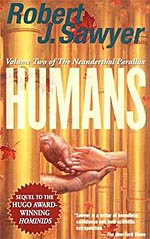
![]() couchtomoon
couchtomoon
8/5/2014
![]()
The cardboard-style storytelling, supported by research-based speculation, remains Sawyer's method in this second installment of his Neanderthal Parallax series. In Hominids (2002), a Neanderthal is transported from his alternate universe to our human-populated Earth, and must deal with the culture shock of living among dirty, murderous humans. In Humans (2003), the key conflict of Hominids is resolved, but new issues arise regarding transit between parallel worlds, magnetic pole shifting, and inter-Hominid romance.
Ponter Boddit is back in Neanderthal-land, but he misses his romantic interest, Mary, a DNA-researcher/rape victim. With the help of his partner Adikor, Ponter finds a way to reestablish the inter-parallax portal and returns to Canada, where he runs into troubles with the U.N., U.S. immigration, and crazy fear-mongers with guns. Diplomatic turmoil occurs, but he still gets to bang Mary, and she thought it was "hot." But the magnetic poles are shifting at different rates from the Neanderthal world, and Ponter has to return home for the commitment ceremony of his daughter and her male partner. Mary returns with him, but wigs out about his boyfriend, but not really, she might be okay with it, but Ponter likes to argue about religion, and she's still having trouble dealing with her rape. They return to Canada together, and trick a police sergeant into showing them another woman's rape kit. Ponter smells the panties, then sniffs out Mary's rapist and castrates him.
Yup. That happens.
In addition to the stale delivery I mentioned in my previous post, product placement becomes a major distraction in this segment of the tale, with enthusiastic references to Upstate Dairy's Extreme Chocolate Milk, Heluva Good French Onion Dip, Air Canada, Philly steak sandwiches at Pat's, Molson Canadian, Good Morning America, the Late Show with David Letterman, and Toronto TV. Not only are these references disruptive to the narrative , but one can only wonder if they helped to finance this trilogy. On top of that, one gets the sense that some of the characters in the story, particularly the scholars and reporters, are actually based on real people who helped to instruct and promote the series. It might be a case of, "If you give me an interview, I'll put you in my story!"
There's not much more to say about this Neanderthal-out-of-heavy-water tale. The more interesting bits of Sawyer's Neanderthal world are described in the first novel, and yet the thin, artificial narrative clunks onward. The third book in this series is called Hybrids, which seems self-explanatory enough to skip it. For readers seeking more genuine speculative treatment about humanity's early relatives, I recommend Nebula award-winning No Enemy But Time (1982) by Micheal Bishop, which I reviewed at Science Fiction and Other Suspect Ruminations for a series of Micheal Bishop posts.
http://couchtomoon.wordpress.com